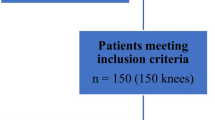Abstract
This study included 527 patients (178 female and 349 male) with unilateral anterior cruciate ligament (ACL) rupture who underwent arthroscopic ACL reconstruction using bone-patellar tendon-bone autograft and interference screw fixation. The follow-up examination was performed by independent observers at a median of 38 (21–68) months after the index operation. At the follow-up, the Lysholm score was 86 (14–100) points, the Lysholm instability subscore was 22 (0–25) points and the Lysholm pain subscore was 19 (0–25) points. The Tegner activity level was 6 (1–10). The one-leg-hop test was 91 (0–167)% of the non-injured knee. The difference in the anterior side-to-side laxity as measured with the KT-1000 arthrometer at 89 Newton (N) was 1.5 (–5–13) mm and the total KT-1000 side-to-side difference at 89 N was 2 (–7–11) mm. Using the International Knee Documentation Committee (IKDC) evaluation system, 177 (33.6%) patients were classified as normal (group A), 211 (40%) as nearly normal (group B), 109 (20.7%) as abnormal (group C) and 30 (5.7%) as severely abnormal (group D). The highest correlation coefficients were recorded between the IKDC evaluation system and the Lysholm score (ρ = 0.66), the patients’ subjective evaluation (ρ = 0.53), the Tegner activity level (ρ = 0.34), all the laxity tests (ρ≥ 0.34) and the one-leg-hop test (ρ = 0.28). The resumption of sporting activities and work as evaluated by the Tegner activity level correlated with the patients’ subjective evaluation (ρ = 0.34) but did not correlate with the laxity tests, i.e., the manual Lachman test (ρ = –0.06) and the total and anterior KT-1000 tests (ρ = –0.06). Furthermore, none of the laxity tests correlated with the functional tests or the patients’ subjective evaluation. We conclude that the IKDC evaluation system is a reliable and useful tool for evaluating the post-operative outcome after an ACL reconstruction.
Similar content being viewed by others
Author information
Authors and Affiliations
Additional information
Received: 18 June 1998 Accepted: 8 October 1998
Rights and permissions
About this article
Cite this article
Sernert, N., Kartus, J., Köhler, K. et al. Analysis of subjective, objective and functional examination tests after anterior cruciate ligament reconstruction A follow-up of 527 patients. Knee Surgery 7, 160–165 (1999). https://doi.org/10.1007/s001670050141
Issue Date:
DOI: https://doi.org/10.1007/s001670050141




